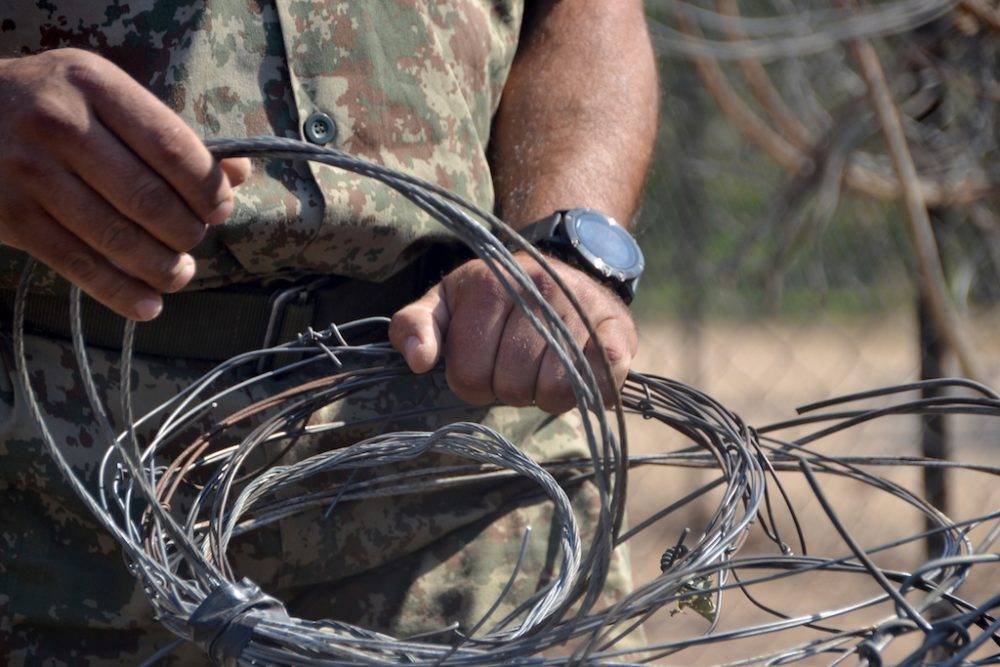
Of all the ways for an animal to die, snaring must be the worst, says Lufuno Netshitavhadulu, a veterinarian at the Kruger National Park.
A large part of his work involves removing snares from wildlife, and “sadly, incidents of snaring have been increasing across Kruger in recent years, especially since the Covid-19 pandemic”, he wrote in South African National Parks (SANParks) 2023/2024 research report.
The use of tracking collars — which send alerts either when animals enter identified snaring hotspot areas or have been stationary for a certain period — has recently become an important tool in managing endangered species such as wild dogs.
In the report, Netshitavhadulu recounted how, on 8 February 2023, tourists reported an injured wild dog with a snare around its neck on SANParks’ Facebook page.
He gathered a team, loaded equipment — including a dart gun and side cutters — and left Skukuza to arrive in Punda Maria, in the northernmost part of the park, in the late afternoon.
“The injured wild dog had a tracking collar, which helped us narrow down the area to play wild dog vocalisations to try and call the animal out into the open,” he said. “Grant Beverley, from Contemplate Wild, accompanied us as he often assists with wild dog rescues.”
Beverley’s photographic record of wild dogs in the park enables individual dogs to be identified by their unique coat patterns while wild dogs that are darted are microchipped to ensure unique identification.
“On that day, as we played the calls, some wild dogs came closer but the snared animal remained out of reach on the side of the mountain that day. The next morning, we changed our tactics, dropped an impala carcass and moved away,” Netshitavhadulu wrote.
The injured dog joined the others to feed on the impala. “I realised how badly injured the dog was with the snare strangling him so that he could hardly eat.
At last, he moved into a good position; I darted him. We treated him as best as possible and transferred the collar to another pack mate so that it would not irritate the wound.”
Heavy rains the next day made the roads impassable and the dogs moved on beyond their reach. Then, on 4 April last year, a pack of wild dogs was sighted in front of Punda Maria camp.
“I left for Punda immediately as collars on this pack had stopped working and we needed to place a collar on a female animal. Males are unreliable because they often leave the pack.”
Only males approached the vehicle and the team darted the closest one. While collaring this wild dog, Netshitavhadulu noticed open wounds on his back legs, probably from a snare, and he treated the wounds.
“I scanned for a microchip and sent pictures of the wild dog to Grant. Grant immediately recognised the wild dog by the colour patterns and responded: ‘Have you forgotten your dog?’
“It was the wild dog I had treated all those months ago, with the scar so well healed that it was not visible. The dog’s ID was soon confirmed from the microchip number.”
Feeling jubilant, Netshitavhadulu drove back to Skukuza. But, on 4 June last year, he woke up to an alert from the collar monitoring system. The collar on the Punda wild dog had stopped moving for a certain length of time, usually an indication that the dog was dead.
On investigation, its body was found in a snare.
“SANParks vets go to great lengths to remove snares and treat the animals,” he wrote. “It is, however, not easy to locate, immobilise and remove snares from wild animals. These animals are very mobile and it often takes a lot of time to find them, including long drives to remote areas.”
Wild dogs are not the only animals being caught in snares — more than 30 elephants were caught in 2023 alone, as well as hyenas and lions.
“I used to often be called to remove snares from animals in the Phabeni area along the Sabie River, but good efforts to remove snares there by rangers and Honorary Rangers have resulted in an immense reduction in the occurrence of snared animals.”
A snare removal campaign has been launched in the Punda area, but its vastness and inaccessibility complicate the task, Netshitavhadulu said. “Nevertheless, these are crucially important interventions, because you cannot save wild dogs by running around with dart guns and side cutters.”
Thousands of snares are removed in the Kruger each year, according to another article on hunting with snares by a team of scientists in SANParks’ research report. Hundreds of snare-related injuries to animals are reported and attended to by vets.
“Snaring is indiscriminate and negatively impacts biodiversity and animal welfare, including that of rare and endangered species,” wrote the authors, Louise Swemmer, Helen Mmethi, Martha Themba, Lucia Hlatswayo and Jeremiah Machavi.
“Limiting the impacts of snaring requires significant resources at a time when financial resources for conservation are limited.”
Bushmeat hunting, through the use of snares, traps, poison, weapons or dogs, has been an important part of rural livelihoods and culture in South Africa for many years, the report said. Research from 2018 found that 30% to 60% (and even up to 80%) of households in rural settings in South Africa consume bushmeat.
The depletion of natural resources outside of protected areas has sparked an increase in snare hunting inside them. Very little is known about snaring, despite the importance of understanding the drivers of the practice.
To gain a better understanding, and to collectively discuss workable solutions, Kruger’s social and economic transformation department held a series of six snaring dialogues with local residents — 291 people from 33 villages that are adjacent to Kruger snaring hotspots.
“Participants perceived the primary motivations for snaring to be money, poverty and unemployment followed by the poor condition of the Kruger fence, traditional medicine use and sales, boredom and hunger,” the authors wrote.
Motivations for snaring specific to Limpopo included subsistence and commercial use and trade, people not understanding the value of wildlife as well as internal involvement by rangers. People also felt they had a right to snare “because this park is ours”.
“This divisive expression creates division and anger towards SANParks and leads to vandalism and carelessness towards the park,” the article said.
It said the penalties for snaring were perceived as being too lenient and the activity was seen as a cultural practice, with one participant stating: “Snaring is a way of life.”
In Mpumalanga, motivations for snaring included the desirability of bushmeat because of its affordability and taste, limited environmental awareness, no ranger presence in the area, a feeling of being detached from the park, peer pressure and the use of traditional clothing and attire.
“Participants suggested unemployed youth are primarily involved in snaring activities, with the snarers coming from local and other villages further away. In the case of the latter, snarers work with local residents.
“Children as young as 10 … are involved, mostly as part of the supply chain and not always with the knowledge of their parents, as noted by one participant: ‘Young boys come home with scratches on their legs and blood stains on their clothes indicating that they are involved but they do not bring bush meat home.”
The snaring dialogues have informed a draft integrated anti-snaring framework. It has two main objectives: to reduce the demand for snaring and reducing the effectiveness of snaring events.
“It further sets out to reduce the negative impacts of successful snaring events, through an effective reporting mechanism for sightings of snared animals, as well as ensuring sufficient resources are available to respond effectively to snare cases, including both veterinary requirements and air support.”
M&G



